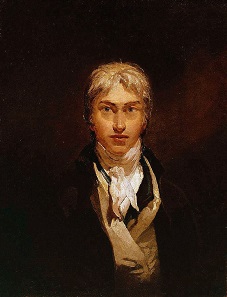by Annika Backe
September 15, 2016 – “New 50 francs note – the SNB lifts the veil of secrecy”. This was the opening line of the online version of the Swiss newspaper magazine NZZ on April 6, 2016. The choice of words says a lot, considering that almost nothing had hitherto been revealed about the redesign of all confederate banknotes, to be completed by 2019. Manuela Pfrunder had turned out victorious with her motif for the 50 francs note, addressing the topic of “wind”. The sole decision maker had been the Swiss National Bank (SNB), which had not included the general public as the intended user of the money. This procedure is rather outdated, as becomes apparent by a look at other countries.
Self-portrait of J.M.W. Turner, ca. 1799. Oil on canvas, Tate Britain.
Great Britain, for instance, recently invited its citizens to contribute to the currency notes’ new design. As for the 20 pound note, the newly established Character Advisory Committee only laid down one specification: The motif was to stem from the visual arts field. After two months, almost 30,000 replies were counted, covering 590 nominations. Bank of England Governor then selected the winner from the shortlist: J.M.W. Turner (1775-1851), one of Britain’s most influential painters.
Something similar happened not long ago with the 20 dollar note in the United States. People exchanged their views in the social media, and the government received any number of design suggestions. When slave liberator Harriet Tubman was chosen, Secretary of the Treasury Jacob J. Lew addressed the Americans in an open letter on April 20, 2016, stating the reasons for this decision.
As early as 2003, the U.S. founded the Citizens Coinage Advisory Committee (CCAC) on coins and medals. This institution does not only comprise scientists and artists but also representatives of the general public, since it “represents the interests of American citizens and collectors”.
On an institutionalized basis, numismatics illustrates a way to practice democracy here. By involving the people in the decision making process trust in the new coins and bank notes is built. Money and currency become interesting again. The mints benefit from this, too, since this interest wins them new customers. These customers then feel confident that their concerns are taken seriously, and so the circle is complete – a win-win situation for everyone involved. It is to be hoped that this example will soon gain wider currency in the Old World as well.
Please find the mentioned NZZ contribution here.
A wealth of information on the election of J.M.W. Turner is available on the Bank of England website.
You can have a look at the British pound notes here.
CoinsWeekly reported on Harriet Tubman on the new American 20 dollar note.
This is the website of the Citizens Coinage Advisory Committee (CCAC).
And how the Committee considers the suggestions made by coin collectors can be read in a report of CCAC member Dennis Tucker.




